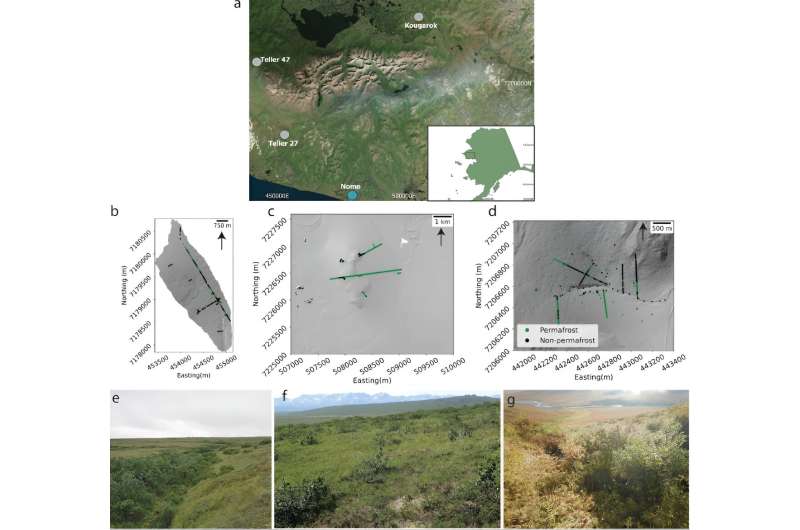This article has been reviewed according to Science X's editorial process and policies. Editors have highlighted the following attributes while ensuring the content's credibility:
fact-checked
peer-reviewed publication
trusted source
proofread
Improved mapping gives decision makers a new tool for protecting infrastructure as Arctic warms

New insights from artificial intelligence about permafrost coverage in the Arctic may soon give policymakers and land managers the high-resolution view they need to predict climate-change-driven threats to infrastructure such as oil pipelines, roads and national security facilities.
"The Arctic is warming four times faster than the rest of the globe, and permafrost is a component of the Arctic that's changing really rapidly," said Evan Thaler, a Chick Keller Postdoctoral Fellow at Los Alamos National Laboratory. Thaler is corresponding author of a paper on an innovative application of AI to permafrost data published in the journal Earth and Space Science.
"Current models don't give the resolution needed to understand how permafrost thaw is changing the environment and affecting infrastructure," Thaler said. "Our model creates high-resolution maps telling us where permafrost is now and where it is likely to change in the future."
The AI models also identify the landscape and ecological features driving the predictions, such as vegetative greenness, landscape slope angle and the duration of snow cover.
AI versus field data
Thaler was part of a team with fellow Los Alamos researchers Joel Rowland, Jon Schwenk and Katrina Bennett, plus collaborators from Lawrence Berkeley National Laboratory, that used a form of AI called supervised machine learning. The work tested the accuracy of three different AI approaches against field data collected by Los Alamos researchers from three watersheds with patchy permafrost on the Seward Peninsula in Alaska.
Permafrost, or ground that stays below freezing temperature two years or more, covers about one-sixth of the exposed land in the Northern Hemisphere, Thaler said. Thawing permafrost is already disrupting roads, oil pipelines and other facilities built over it and carries a range of environmental hazards as well.
As air temperatures warm under climate change, the thawing ground releases water. It flows to lower terrain, rivers, lakes and the ocean, causing land-surface subsidence, transporting minerals, altering the direction of groundwater, changing soil chemistry and releasing carbon to the atmosphere.
Useful results
The resolution of the most widely used current pan-Arctic model for permafrost is about one-third square mile, far too coarse to predict how changing permafrost will undermine a road or pipeline, for instance. The new Los Alamos AI model determines surface permafrost coverage to a resolution of just under 100 square feet, smaller than a typical parking space and far more practical for assessing risk at a specific location.
Using their AI model trained on data from three sites on the Seward Peninsula, the team generated a map showing large areas without any permafrost around the Seward sites, matching the field data with 83% accuracy. Using the pan-Arctic model for comparison, the team generated a map of the same sites, but the model only managed 50% accuracy.
"It's the highest accuracy pan-Arctic product to date, but it obviously isn't good enough for site-specific predictions," Thaler said. "The pan-Arctic product predicts 100% of that site is permafrost, but our model predicts only 68%, which we know is closer to the real percentage based on field data."
Feeding the AI models
This initial study proved the concept of the Los Alamos model on the Seward data, delivering acceptable accuracy for terrain similar to the location where the field data was collected. To measure each model's transferability, the team also trained it on data from one site then ran the model using data from a second site with different terrain that the model had not been trained on. None of the models transferred well by creating a map matching actual findings at the second site.
Thaler said the team will do additional work on the AI algorithms to improve the model's transferability to other areas across the Arctic. "We want to be able to train on one data set and then apply the model to a place it hasn't seen before. We just need more data from more diverse landscapes to train the models, and we hope to collect that data soon," he said.
Part of the study involved comparing the accuracy of three different AI approaches—extremely randomized trees, support vector machines and an artificial neural network—to see which model came closest to matching the "ground truth" data gathered in field observations at the Seward Peninsula. Part of that data was used to train the AI models. Each model then generated a map based on unseen data predicting the extent of near-surface permafrost.
While the Los Alamos research demonstrated a marked improvement over the best—and widely used—pan-Arctic model, the results from the team's three AI models were mixed, with the support vector machines showing the most promise for transferability.
More information: E. A. Thaler et al, High‐Resolution Maps of Near‐Surface Permafrost for Three Watersheds on the Seward Peninsula, Alaska Derived From Machine Learning, Earth and Space Science (2023). DOI: 10.1029/2023EA003015
Journal information: Earth and Space Science
Provided by Los Alamos National Laboratory




















